Various events during the Month for a Culture of Peace!
The Month for a Culture of Peace logo
The Month for a Culture of Peace logo
At each event during the period, we wore yellow-green PR ribbons, our image color, and displayed our logo to promote the "Culture of Peace" and encourage support for this initiative.
Peace Culture Lecture (November 1)
As the opening event of the Month, we welcomed actor Ms. Sahel Rosa to give a lecture on the topic of "Encounters with people gave me the strength to live."
Ms. Sahel Rosa giving her lecture
In the midst of all this, Ms. Sahel related many heartwarming episodes that gave her the opportunity to live positively through encounters with various people, and they made the audience think deeply about their own way of being and how they relate to others.
After overcoming her painful past, Ms. Sahel's many positive messages, spoken with a bright and wonderful smile, greatly touched the hearts of the audience, and the venue was wrapped in a warm circle of emotion. Ms. Sahel's story, which expressed her sympathy and support for initiatives for the Month for a Culture of Peace, spoke to the spirit of Hiroshima desiring for peace and the spirit of peace culture, making it a fitting opening event for the Month.
Citizens' Peace Culture Event: Connecting Thoughts on Peace to the Future (November 3)
The Citizens' Peace Culture Event: Connecting Thoughts on Peace to the Future was held at the International Conference Center's Large Conference Room Dahlia. Ten groups of young people and citizens who are engaged in peace activities in Hiroshima presented their daily activities and thoughts on peace through stage presentations and exhibits.Hiroshima Mayor Kazumi Matsui opened the event by saying, "This event, where we share our thoughts on peace through the presentation of artistic and cultural activities such as music and art, is truly an event that will instill a 'culture of peace', and I am pleased that so many citizens are participating."

Children who performed in the musical play, together with Mayor Matsui and the author Mr. Koide.
Mr. Takashi Koide, the author of the picture book, came to the venue to watch the children's performance, and at the end, he and the mayor of Hiroshima joined the children on stage to celebrate the finale together.

(left) Children who performed in the musical play, together with Mayor Matsui and the author Mr. Koide.
(right) Pan flute performance by the Senda Pan Flute Choir

Pan flute performance by the Senda Pan Flute Choir

Presentation by Chugoku Shimbun newspaper junior writers

(left) Presentation by Chugoku Shimbun newspaper junior writers
(right) Performance of Creative Play for Peace: I PRAY

Performance of Creative Play for Peace: I PRAY
There was also a corner at the venue where children could draw pictures on paper recycled from Orizuru paper cranes and have them made into badges to take home as souvenirs, and a hands-on corner where visitors could write messages of peace on pigeon-shaped stickers and paste them. These were ways that visitors could express their thoughts on peace through their own creations. There was also an information corner with flyers of various events for the Month for a Culture of Peace to promote the month’s events.

Exhibits of participating groups

Peace messages
・"May the world be free of nuclear weapons! May everyone in the world lives with a smile."
・"I wish for a time when people all over the world can forget their tears and smile every day."
・"I wish for a world where everyone can live with a kind heart..."
By participating in this event, the young generation who are working for peace were able to interact with each other, and there were warm words of support for their efforts, making it an opportunity for participants and visitors alike to renew their commitment to peace.
Online event: A-bomb Piano Concert: An investigation of peace playing an A-bombed piano (available online from November 13)
There are many forms of peace culture, and music expressed with a wish for peace is one of them. In order to encourage people to think about peace through familiar music, the A-bomb Piano Concert, in which musicians associated with Hiroshima perform in memory of the A-bomb victims, has been available online since November 13, and has been viewed by more than 870 people so far. The A-bombed piano used in the concert was the one that Ms. Akiko Kawamoto loved to play, which is on display on the second floor of the Rest House in Peace Memorial Park. Akiko was 19 years old when she was exposed to the atomic bomb while working as a mobilized student, and she died on August 7, the day after the atomic bombing. The piano is still pierced with fragments of glass that were scattered by the blast of the atomic bomb, and with its beautiful sound, it conveys to us the tragedy of the atomic bombing. At the concert, "Farewell Song", one of Akiko's favorite Chopin pieces, was performed by erhu Chinese violin player Jiang Xiaoyan from Dalian, China, and pianist Masakazu Shintaku. Other performances included "Sunset" by soprano Shiho Nakagawa and pianist Ayako Yoshikawa, "Go Up Hiroshima" by Hiroshima-born New York-based jazz pianist Takeshi Obayashi, and "Memory of Life" by singer-songwriter Kazumi Nikaido, who lives in Otake City, Hiroshima. In addition, Mr. Obayashi, Ms. Peace messages Nikaido, and Ms. Jiang performed "One Pencil", expressing their thoughts on peace to the sounds of the A-bombed piano.
(left) Ms. Nakagawa (right) and Ms. Yoshikawa (left) performing "Sunset"
(right) Mr. Obayashi (left), Ms. Nikaido (center), and Ms. Jiang (right) performing "One Pencil"
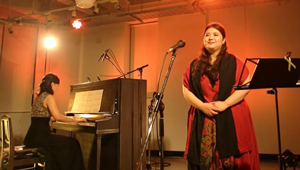
Ms. Nakagawa (right) and Ms. Yoshikawa (left) performing "Sunset"
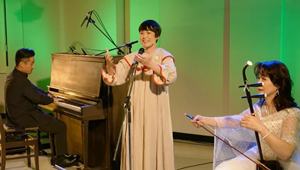
Mr. Obayashi (left), Ms. Nikaido (center), and Ms. Jiang (right) performing "One Pencil"
PEACE Kids Campus (November 14)
An art workshop was held for children to think about the importance of peace.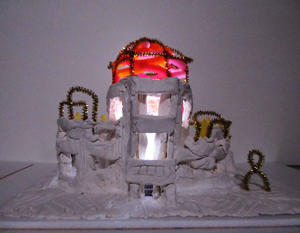
Illuminated artwork "A-bomb dome"
At the end, everyone illuminated their art creations and cheered at the glittering work.
The children who participated in the event said, "It was fun. I will come again." From the parents, we received messages such as, "I hope the peaceful time of making crafts with children will continue forever."
It was an opportunity for parents and children to think about the importance of peace together through watching peace education animations and creating art objects.
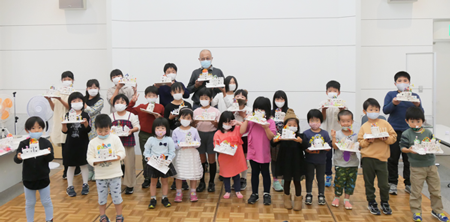
Participating children and Professor Morinaga holding their completed works
Communicating Hiroshima and Nagasaki to Each Other -Hiroshima Session 2021- (November 20)
As the A-bomb survivors are aging, the "Let's Tell Each Other About Hiroshima and Nagasaki: Hiroshima Association 2021" event was held to convey the thoughts of A-bomb survivors, mainly through recitation, with the belief that it is important for various generations to pass on the A-bomb experience in their own ways. This event was planned for the first time by volunteers from various organizations that have been conducting A-bomb testimony reading activities in Hiroshima City, and was co-sponsored by our Foundation.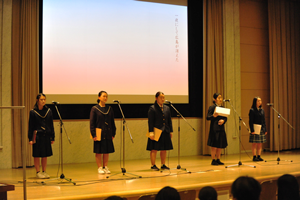
High school students reading out the A-bomb testimony of Hiroshima hibakusha Emiko Okada
Visitors left comments such as "It was good to see people of all ages, including high school students, participating in the event," and "the variety of the performances provided a valuable opportunity to think about peace." The event became an opportunity for the performers and visitors to share their thoughts of the hibakusha of Hiroshima and Nagasaki and renew their commitment to peace.
Hiroshima Peace Forum: screening of film "The Vow from Hiroshima" (November 27)
As the closing event of the Month for a Culture of Peace, we screened the documentary film "The Vow from Hiroshima", which traces the life of Setsuko Thurlow, an A-bomb survivor living in Canada who worked for the entry into force of the TPNW and gave the Nobel Peace Prize acceptance speech at the ICAN Nobel Peace Prize Ceremony in 2017. Yumi Kanazaki, Director of the Hiroshima Peace Media Center of the Chugoku Shimbun newspaper, also gave a lecture titled "The journey to the entry into force of the Treaty on the Prohibition of Nuclear Weapons and the future".Ms. Kanazaki gave a clear explanation of the TPNW and praised Germany's announcement to participate as an observer at the First Meeting of States Parties. She also talked about what she felt through her years of reporting and anecdotes with Setsuko Thurlow. Finally, she introduced an audio message from the film's producer, Michi Takeuchi, who was born in Hiroshima and lives in New York, saying, "I hope this film will inspire you to take action for a peaceful world."
Visitors commented, "I felt once again that the accumulation of small actions is important," and "I was moved by the energy in each of Ms. Thurlow's words." Through the lecture and the film, we were able to empathize with Setsuko Thurlow's thoughts and share with the audience the importance of each of us wishing for peace in our daily lives and taking action, even in small ways.
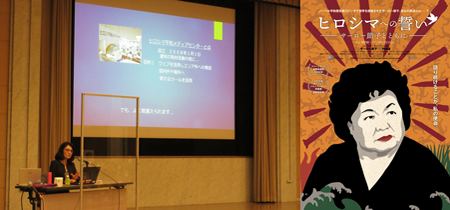
The lecture and the film poster
Winner of the Peace Culture Award decided!
As one of the activities of the Month for a Culture of Peace, the Hiroshima City Board of Education has awarded the Peace Culture Prize to four of the entries in the annual "Messages from Our Young People" contest. The works express a strong desire for peace in daily life.The entries were based on the theme, "I want a Hiroshima like this", and were essays, manga comics, and illustrations that expressed the importance of the city in which they live and their ideal city. The works can be viewed on this Foundation's website.
6th grade student, Hiroshima City Waseda Elementary School
"Helping Each Other in Hiroshima"
The people of Hiroshima did not give up, no matter how much the city was torn apart. Everyone worked together, helped each other, and connected "Hiroshima" to our generation. That's why it's my turn now.
I hope that the town will become a place where people can enjoy their daily lives by helping each other out whenever they are in need. It was because I experienced this kind of help.
It was when I was a grade 2 student. I was walking home from school with a friend when I sprained my ankle. At that time, my friends around me went to call the teacher, and the teacher came and helped me. The teacher came and helped me. I felt so relieved. From this experience, I wanted to bring this idea of "helping each other" to everyone.
Hiroshima is a city of people helping each other. Helping each other brings happiness to everyone.
3rd year student, Hiroshima City Kabe High School
"What We Can Pass On to Future Generations"
My great-grandmother was a nurse at the time who was sent to the areas hit by the atomic bomb. My great-grandmother was with her friends, realized that she had left something in her room and ran back to get it. Shortly after that, the atomic bomb was dropped nearby. Only my great-grandmother survived because she went home to retrieve something she had forgotten, while the rest of her friends were caught in the bombing. Partly because she was a nurse, she was not able to eat meat again after that day.
I want to pass on the story I heard from my great-grandmother to future generations, and I want as many people as possible to know that this kind of thing should never happen. To the extent that the people of that time suffered, we want to take on the atomic bombing and pass it on to future generations to protect the peace of the SDGs.
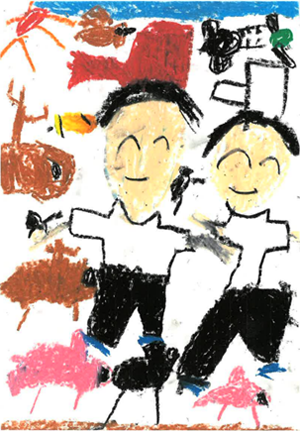
"Peace is nice"

"Peace is nice"
1st grade student, Hiroshima City Konan Elementary School
"Peace is nice"; I think it's nice to have a peaceful city, so I drew a picture of people and animals laughing together.